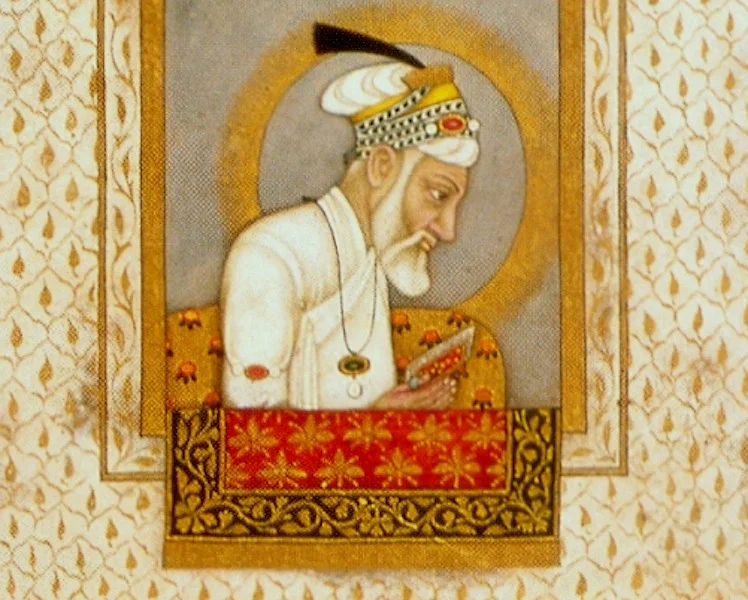In the religion of the Musulmans it is even improper to look at the temple: Aurangzeb


The rivalry between the two brothers Dara Sikoh and Aurangzeb made a struggle for succession appear likely when Shah Jahan became very sick in 1657. By the time Shah Jahan unexpectedly recovered, the situation was too serious for either son to back down. Aurangzeb demonstrated excellent tactical and strategic military competence, great dissimulation abilities, and relentless determination in the war for power (1657–1659). In May 1658, after decisively defeating Dara at Samugarh, he imprisoned his father in his own palace in Agra. One brother was killed by Aurangzeb as he consolidated his power, and he also had two other brothers, a son, and a nephew put to death.
After Shah Jahan’s critical illness in September 1657, the sons of the Mughal emperor engaged in a decisive battle for the throne at Samugarh on May 29, 1658. The third and fourth sons of the emperor Shah Jahan, princes Aurangzeb and Murad Bakhsh, engaged in combat with the eldest son and heir apparent, Dara Shikoh, on the opposing side. Dara had fled to Samugarh, south of the Yamuna (Jumna) River, some 10 miles (16 km) east of Agra (Shah Jahn’s palace), after Aurangzeb had flanked Dara defensive line along the Chambal River by discovering a little-used and unguarded ford. Approximately 60,000 soldiers made up Dara’s army, although Aurangzeb was more skilled.
The battle, which took place at the hottest time of the year in north India, was determined when Dara descended from his elephant at a crucial juncture, which his warriors misunderstood for his demise. Following the fight, Aurangzeb imprisoned Shah Jahan and his brother Murad, while Dara was beheaded death in 1659 as a result of a protracted pursuit and a second defeat.
Dara was put to death, beheaded, and had his head served to Aurangzeb on a platter while his headless body was carried through Delhi’s streets on an elephant (to the sorrow of the local population who loved Dara).
When Aurangzeb discovered that his brother Dara Shikoh had given a stone railing to the Keshava Rai temple in Mathura (which Aurangzeb later destroyed), he immediately issued another Akhbarat: “In the religion of the Musulmans it is even improper to look at the temple and I have ordered for the railing to be removed immediately.” (13 October 1666).
AURANGZEB also issued orders prohibiting the meetings of Hindus and Sikhs and forbidding them from riding any horse, elephant, or palanquin. Nobody has ever forgotten Shri Guru Teg Bahadur’s martyrdom, which resulted in the founding of the Khalsa by his son Shri Guru Gobind Singh. Shri Guru Teg Bahadur was decapitated on November 24, 1675, after watching his three primary students be tortured to death. But he also gave his adversaries horrifying demises. For instance, take the case of Raja Shambhaji, the son of Shivaji Maharaj, who was accidentally abducted on February 15, 1689, together with his right-hand general Kavi Kailash, and brought before the imperial court in clown attire.
They were both told by Aurangzeb in broad durbar that if they converted to Islam, their deaths would be spared; but, when they refused, that very night their eyes were gouged out and their tongues were severed. They were then subjected to fifteen days of torture, and on March 11, 1689, their bodies were finally chopped into pieces and fed to dogs while their severed heads, which had been filled with straw, were exhibited around present-day Maharashtra.
Many times, historians laud Aurangzeb’s rule as a time when the arts, such as music and painting, flourished. However, one particular Akhbarat argues the opposite. In order to impose the rigorous adherence to the Sharia, Aurangzeb made a variety of regulations in 1665, including the expulsion of court astronomers and poets, the banning of Tazias, restrictions on pilgrim gatherings, and, most notably, the outlawing of music at his court. Khalid Khan, one of his representatives, wrote: “Distinguished and well known musicians in the service of the court are hereby forbidden to perform and orders have also been issued for the ban of dancing.” In protest, the musicians, who were all Hindus converted to Islam, staged a mock burial of their instruments. When the emperor learnt about it, he said: “Bury them so deep that no sound or echo may rise again…”
Source: Britannica
François Gautier’s latest book, Aurangzeb’s Iconoclasm
DISCLAIMER: The author is solely responsible for the views expressed in this article. The author carries the responsibility for citing and/or licensing of images utilized within the text.
